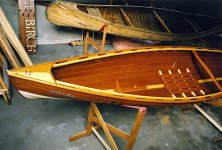The question posed in my title and OP about eliminating the inside glass on on stripper has been answered.
The 1884 book I linked says that the planks on a lapstrake canoe are generally 1/4" cedar or pine. Also, for the canoe historian, the book has extremely detailed illustrations and lists of materials and tools needed to build canoes, paddles, rudders, sails, wells, cockpits, aprons, centerboards (of iron!), tabernacles, plus gear such as tents, beds, stoves and lights.
If the 9' Sairy Gamp weighs 10.5 lbs., I now wonder how much a 15' lapstrake canoe would weigh if made like the Sairy Gamp with thin ribs, perhaps two thwarts, and a bottom mounted pedestal seat.

The Nomad site says their 12', 27" beam lapstrake canoe weighs 27 lbs. It has no ribs and one thwart behind the bottom seat.


Many here may recall the interesting thread from
@Sabs in Copenhagen, Denmark, seeking help in caulking leaks in his unglassed carvel canoe.
Hi everyone, I hope someone can help. I just bought an unglassed wood canoe that has been out of the water for at least two years. It will need a new coat of spar varnish and a soak to re hydrate the wood and seal the gaps. But which comes first? Varnish or water? And how long do I soak it...
www.canoetripping.net




